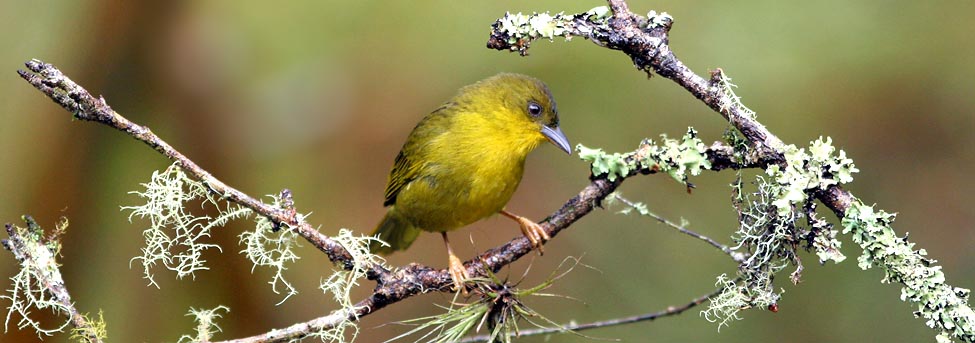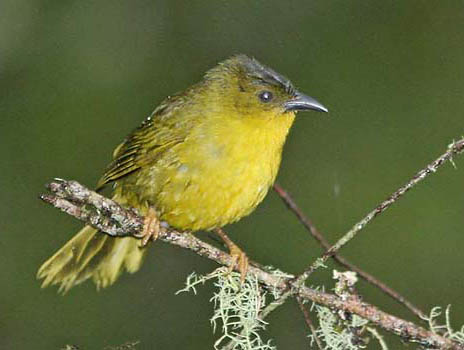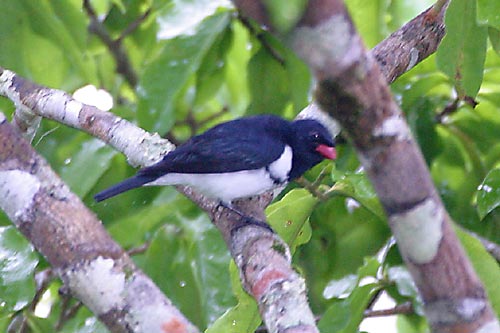
a web page by Don Roberson |
MITROSPINGID TANAGERS Mitrospingidae |
|
 |
The last decade or so has seen many surprises in the molecular evidence of New World passerines, and especially the "nine-primaried" passerines near the end of any checklist. Birds that were once considered "tanagers" — like Scarlet, Summer and Western Tanagers — are, in fact, related to cardinals and grosbeaks. Likewise, a whole lot of birds once considered to be "finches" of some sort — the Galapagos finches, to name just one set — are, in fact, tanagers; Burns et al. 2014; see the Tanager page for an overview). Several of these studies (e.g., Yuri & Mindell 2002, Kilicka et al. 2007) found that certain genera of "tanagers" were neither fish nor fowl (i.e., neither tanagers nor grosbeaks) but a separate lineage. The most recent evidence is in Barker et al. (2013), the those authors propose a separate Family for four species of these uncertain taxa. The family Mitrospingidae includes three genera: Mitrospingus, Lamprospiza, and Orthogonys. Olive-green Tanager is the only species in genus Orthogonys. Very little is known about its natural history, although it apparently lives in small bands of up to two-dozen birds in the understory of the Atlantic forests. The Latin name for the new Family is derived from the earliest-named taxa in what is now the Mitrospingidae: Mitrospingus cassinii, the Dusky-faced Tanager (below). It is mostly a foothill forest bird of the Caribbean slope of Central America and Andean foothills in Colombia and Ecuador. Small flocks travel in noisy single-species groups, rarely mixing with other species. They seem to be constantly on the move, communicating through a harsh chatter, and can be difficult to see in the dark understory. These behaviors recall some ant-tanagers and Carmiol's Tanager Chlorothraupis carmioli, both of which remain in the Tanager family Thraupidae. |
 |
Dusky-faced Tanager was a dominant species in subtropical forest along the old Buenaventura Road in Colombia back in July 1975 (up to 80/day when multiple flocks encountered). The plumages of the three other mitrospingid tanagers are comparatively dull, so Red-billed Pied is the single "odd" member of the family in plumage and behavior. It, too, occurs in flocks, but usually just 6-10. These could be extended family groups. Again, not much is yet known about this "new" family of tanager-like birds. |
Photos: Both photos of Olive-green Tanager Orthogonys chloricterus were taken at Intervales NP, Brazil on 2 Aug 2010. The Dusky-faced Tanager Mitrospingus cassinii was at La Mesa, Coclé, Panama, on 19 Feb 2022. Arthur Grosset photographed the Red-billed Pied Tanager Lamprospiza melanoleuca at Caxiuanã, Pará, Brazil, in July 2006 .
Bibliographic note: There is no "family book" per se. The species in this set have been previously covered in books on tanagers, such as Islet & Isler (1987) and the tanager chapter in the Handbook of the Birds of the World. Literature cited:
|
 This is Olive-green Tanager (above & left), an endemic to coastal southeastern Brazil. A nice enough bird but hardly one of the many spectacular tanagers of the Neotropics. So why is it headlining a Family page?
This is Olive-green Tanager (above & left), an endemic to coastal southeastern Brazil. A nice enough bird but hardly one of the many spectacular tanagers of the Neotropics. So why is it headlining a Family page?  In contrast to the other three species in this family (i.e., Olive-green Tanager, Dusky-faced Tanager, and Olive-backed Tanager Mitrospingus oleagineus), Red-billed Pied Tanager prefers the canopy of lowland forest
In contrast to the other three species in this family (i.e., Olive-green Tanager, Dusky-faced Tanager, and Olive-backed Tanager Mitrospingus oleagineus), Red-billed Pied Tanager prefers the canopy of lowland forest